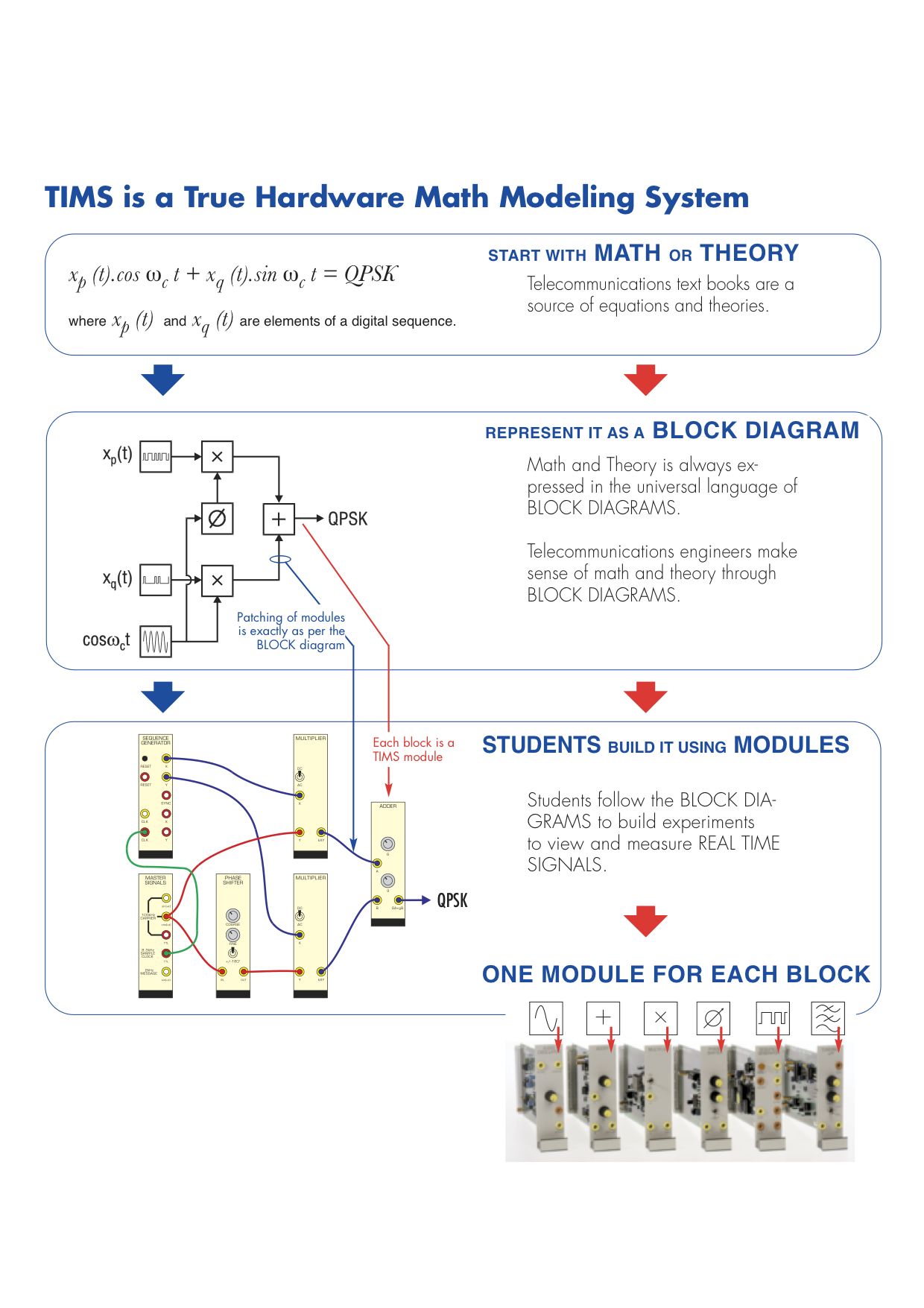Telecommunication Instructional Modeling System on:
[Wikipedia]
[Google]
[Amazon]
TIMS, or Telecommunication Instructional Modeling System, is an electronic device invented by Tim Hooper and developed by Australian engineering company Emona Instruments that is used as a
 TIMS uses a block diagram-based interface for experiments in the classroom. It can model mathematical equations to simulate electric signals, or it can use block diagrams to simulate telecommunications systems. It uses a different hardware card to represent functions for each block of the diagram.
TIMS consists of a server, a chassis, and boards that can emulate the configurations of a telecommunications system. It uses electronic circuits as modules to simulate the components of analog and digital communications systems. The modules can perform different functions such as signal generation,
TIMS uses a block diagram-based interface for experiments in the classroom. It can model mathematical equations to simulate electric signals, or it can use block diagrams to simulate telecommunications systems. It uses a different hardware card to represent functions for each block of the diagram.
TIMS consists of a server, a chassis, and boards that can emulate the configurations of a telecommunications system. It uses electronic circuits as modules to simulate the components of analog and digital communications systems. The modules can perform different functions such as signal generation,
Official website
{{DEFAULTSORT:Telecommunication Instructional Modeling System 1971 establishments Electronics Electrical engineering Telecommunications
telecommunications
Telecommunication is the transmission of information by various types of technologies over wire, radio, optical, or other electromagnetic systems. It has its origin in the desire of humans for communication over a distance greater than that fe ...
trainer in educational settings and universities.
History
TIMS was designed at theUniversity of New South Wales
The University of New South Wales (UNSW), also known as UNSW Sydney, is a public research university based in Sydney, New South Wales, Australia. It is one of the founding members of Group of Eight, a coalition of Australian research-intensive ...
by Tim Hooper in 1971. It was developed to run student experiments for electrical engineering communications courses. Hooper’s concept was developed into the current TIMS model in the late 1980s. In 1986, the project won a competition organized by Electronics Australia
''Electronics Australia'' or ''EA'' was Australia's longest-running general electronics magazine. It was based in Chippendale, New South Wales.
Publication history
It can claim to trace its history to 1922 when the '' Wireless Weekly'' magazine ...
for development work using the Texas Instruments TMS320
Texas Instruments TMS320 is a blanket name for a series of digital signal processors (DSPs) from Texas Instruments. It was introduced on April 8, 1983 through the TMS32010 processor, which was then the fastest DSP on the market.
The processor is ...
. Emona Instruments also received an award for TIMS at the fifth Secrets of Australian ICT Innovation Competition.Methodology
 TIMS uses a block diagram-based interface for experiments in the classroom. It can model mathematical equations to simulate electric signals, or it can use block diagrams to simulate telecommunications systems. It uses a different hardware card to represent functions for each block of the diagram.
TIMS consists of a server, a chassis, and boards that can emulate the configurations of a telecommunications system. It uses electronic circuits as modules to simulate the components of analog and digital communications systems. The modules can perform different functions such as signal generation,
TIMS uses a block diagram-based interface for experiments in the classroom. It can model mathematical equations to simulate electric signals, or it can use block diagrams to simulate telecommunications systems. It uses a different hardware card to represent functions for each block of the diagram.
TIMS consists of a server, a chassis, and boards that can emulate the configurations of a telecommunications system. It uses electronic circuits as modules to simulate the components of analog and digital communications systems. The modules can perform different functions such as signal generation, signal processing
Signal processing is an electrical engineering subfield that focuses on analyzing, modifying and synthesizing ''signals'', such as audio signal processing, sound, image processing, images, and scientific measurements. Signal processing techniq ...
, signal measurement, and digital signal processing
Digital signal processing (DSP) is the use of digital processing, such as by computers or more specialized digital signal processors, to perform a wide variety of signal processing operations. The digital signals processed in this manner are ...
.
Variants
The block diagram approach to modeling the mathematics of a telecommunication system has also been ported across to other domains.Simulation
Where the blocks are patched together onscreen to mimic the hardware implementation but with a simulation engine (known as TutorTIMS).Remote access
It can be used by multiple students at once across the internet or LAN via a browser based client screen. This utilises a statistical time division multiplexing architecture in the control unit. The method is applied both to Telecommunications and Electronics Laboratories (known as netCIRCUITlabs).V References
External links
Official website
{{DEFAULTSORT:Telecommunication Instructional Modeling System 1971 establishments Electronics Electrical engineering Telecommunications